Last updated September 2022
This post is long, perhaps too long to keep your attention but I thought that this procession was particularly fascinating and therefore, I want to try to describe it as accurately and lovingly as possible. I hope the photos will help break up this heavy text for you. Sorry about the quality of the images too, the lighting was not so good but I hope they’ll give you a bit of an idea anyway!
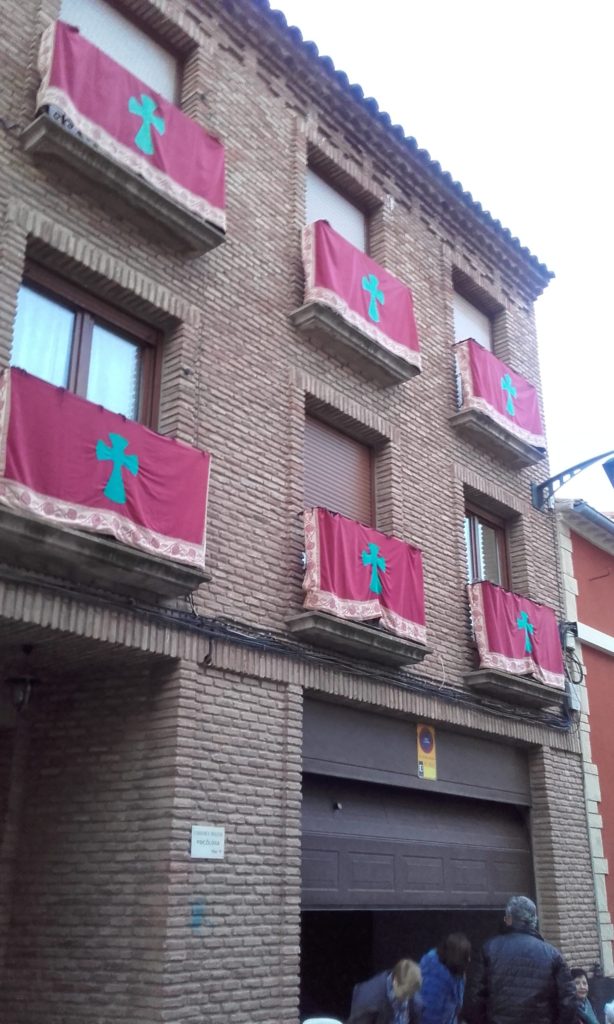
There is a very important procession on the evening of Good Friday in Calahorra. The procession lasted around 3 hours. It was meant to start at 8:30 pm but I think it was a little later.
There are many processions during Easter Week but I think this one is the best one as it is the biggest. You see all the pasos (floats) and all the bands. Calahorra has 16 pasos, more than a lot of nearby towns and cities.
Each paso is illuminated, the streets are quite dark at night, even with the street lights, therefore even without avidly looking, you can sense/see a paso coming because the street becomes that much brighter. Some pasos are smaller and simpler, therefore, they have simple lights, like little lanterns. Others are bigger, grander and have stained glass lanterns and some really grand ones have elaborately decorated lights.
These really stood out for me, they make the pasos look that much more impressive, and beautiful. I had seen them in the St. Francis’ Church (Iglesia de San Francisco) in Calahorra but they look so different on the street, illuminated and decorated with fresh flowers. The flowers make a huge difference too, they make the pasos look truly beautiful. So it is better to see them in use and to witness how they carried etc. But if not then do visit them as they are permanent display in the church.
Address:
Iglesia de San Francisco, Rasillo de San Fransisco, Calahorra
Opening times:
Saturday to Sunday: 11:00 – 13:30
Closed December to March
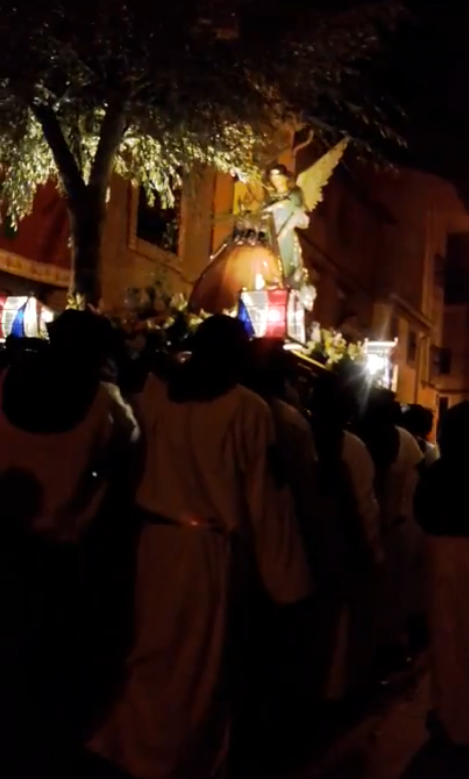
To give you an idea of how big the procession is, to help you understand why it lasts so long, let me break it down for you:
There are 16 pasos and each paso has its own band. I’m sure they aren’t called band but they have their own group of drummers, each group wearing different colours. Some wear white and black, some white and blue, some black and red etc. Also, some wear the pointed hoods, some wear the hoods that cover the heads more snuggly, with no peaks. All must wear black shoes, if they choose to wear shoes, that is. Some people choose to walk the procession barefoot, this is quite a feat. It is a long time and it gets quite cold. Some people also choose to wear chains so you can hear them coming.
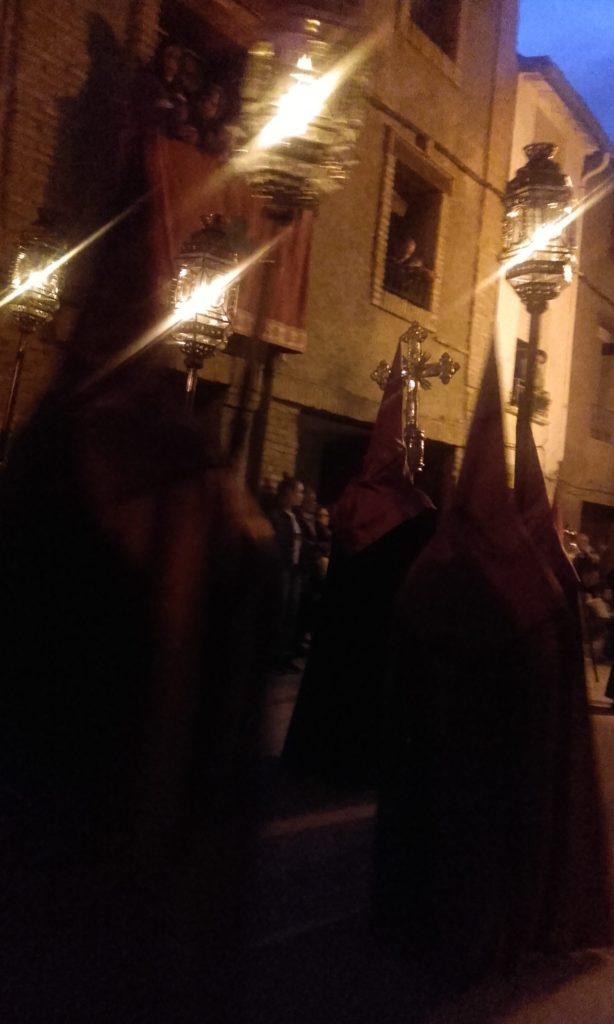
To take 1 paso as an example, there are 3 figures leading the paso’s group: a person holding a flag (flags are also different but not all paso groups have one) flanked by one person on each side, both holding lanterns on sticks. Next, we have the musicians, a group of drummers. Drums of different sizes, some smaller and need two sticks, other much bigger and only require one stick. These sound very impressive, they are really loud and you can feel the vibrations. However, now I can’t enjoy hearing these beats because they have become beats of pain to me. This transformation occurred after I was told that these musicians play the drums so hard that their hand starts to bleed, you can see the blood on the drums. Before that, I naively thought that the drums were stained with age. Silly me. The musicians have a leader who will signal when they need to stop. Trust me, they will need to stop a lot. They musicians need a break from hitting the drums and the people carrying the pasos also need a break, they weigh a lot. It is sort of frowned upon to talk during the procession, people did, but during the breaks it is better not to talk or to talk a little more quietly. Traditionally, there was silence during the whole procession and for some people this is still very important so better to be too careful than to risk offending.
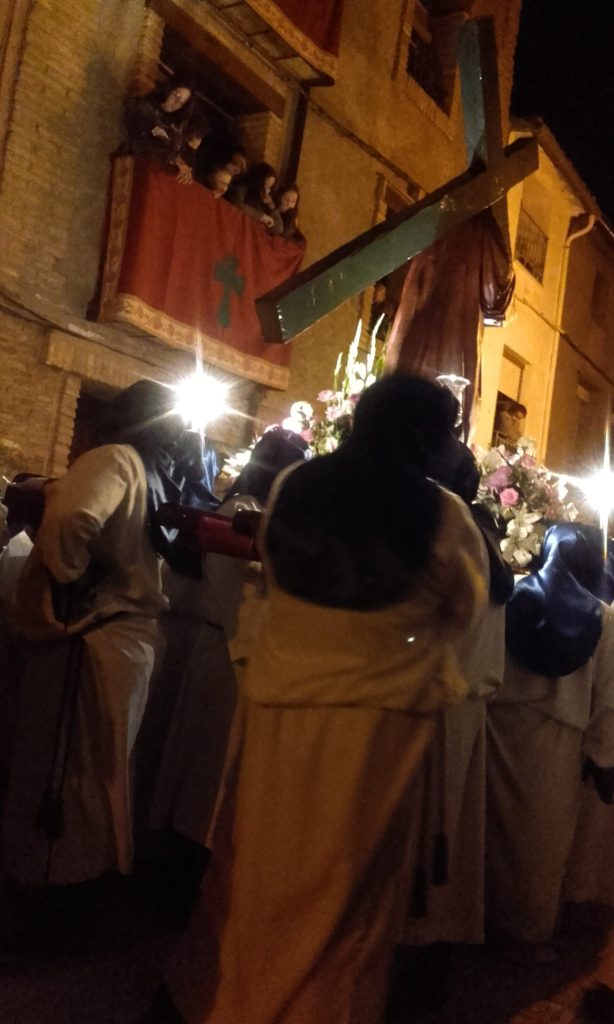
This brings me onto the paso itself. It is a little platform made of wood with a statue or group of statues on top, depending on how big it is. Some of the pasos were so big that they almost took up the width of the street (we were sitting by the garage on one of the smaller streets in the Old Town). It was a really good spot to watch the procession. Depending on the size of the paso, there are a lot of people needed to carry it. Men and women carry it which is great but there are more men than women, from what I noticed.
What I also find amazing is that the carriers did not only need to carefully carry this weight on their shoulders, they needed to walk in a special way too. They step diagonally left and then diagonally right, therefore, the paso sways from side to side, if you are looking down on it you will see it moving from one side to the other, not just zooming in a straight line. Beside these coordinately talented carriers are 4 more people, 2 on each side, they are carrying posts (I’m not sure what word to use for this, but wooden sticks used to rest the paso on during the breaks/pauses/rests).
Sometimes there are people walking behind the paso too, for the children drummers anyway there was a woman carrying extra drumsticks and water. The drumsticks can break, as they really do hit them hard. They hit them with a lot of force from the beginning but sometimes there is an increase in tempo and they begin to beat even harder. It sounds amazing, very special, but it is does make me cringe for them in sympathy. They must enjoy doing it though, a lot of the drummers will perform every year, it is special for them.
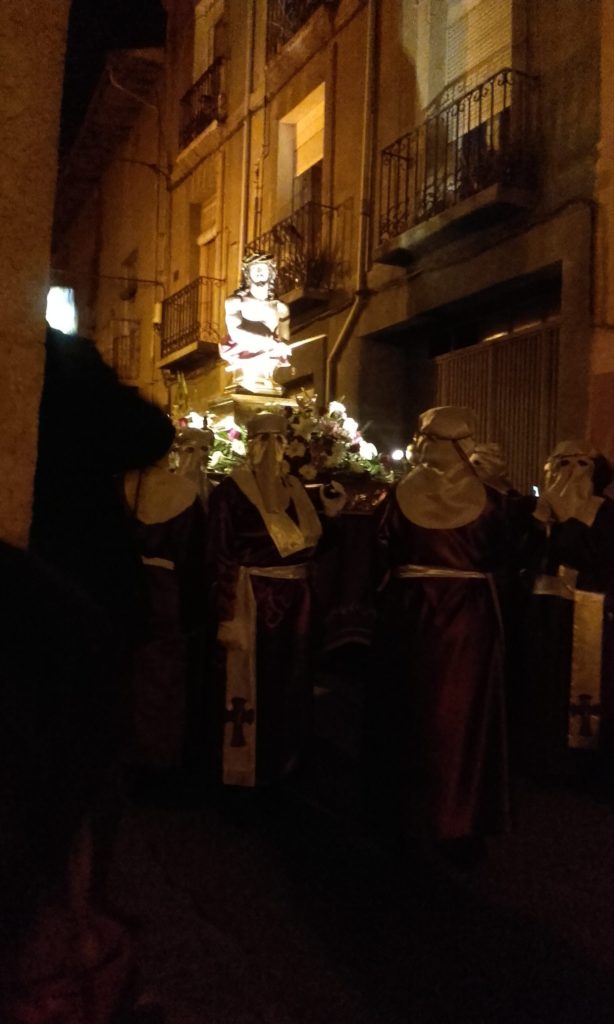
It is a very immersive experience, due to the traditional clothes, the beating of the drums, the constant stream of people, colours, beautiful pasos, it is easy to think that this tradition hasn’t changed with the years. There are only little moments where you are reminded of the present, such as when you see a bottle of water disappear under a drummer’s hood. It looks a little strange and a little bit amusing. The pasos themselves are the most interesting part of the procession for me as they are so unique and special. I can understand whey they are so important, why they are so cherished by the people. They are so important that the processions are cancelled if there is a lot of rain as they can’t risk the rain damaging the pasos. they are very old and only made of wood and paint after all. Similarly, the rain can damage the drums so they need to be careful.
You can read more about it on Calahorra’s Easter website:
http://semanasantacalahorra.es/
It is a unique experience, I have truly never seen any procession like it. The clothes, the drums, the pasos, there is so much to see, so much to savour. And so many details to take in, it is hard to understand it all, but I think I have done quite well. I would love to go back to Spain during Easter again. Calahorra in particular sure knows how to keep up their traditions. It is a very traditional Easter celebration, and taken quite seriously. People don’t cry or shout, unlike in other parts of Spain, it is more serious. I would be interested in seeing Easter celebrated in the South one year but Calahorra’s celebrations are well worth seeing and I hope to see them one year again. I hope I’ve also been able to paint a bit of picture for you and hopefully you’ll be able to see them yourself one day.




Thanks for your blog, nice to read. Do not stop.
Hey, thank you very much for saying so. I appreciate it.